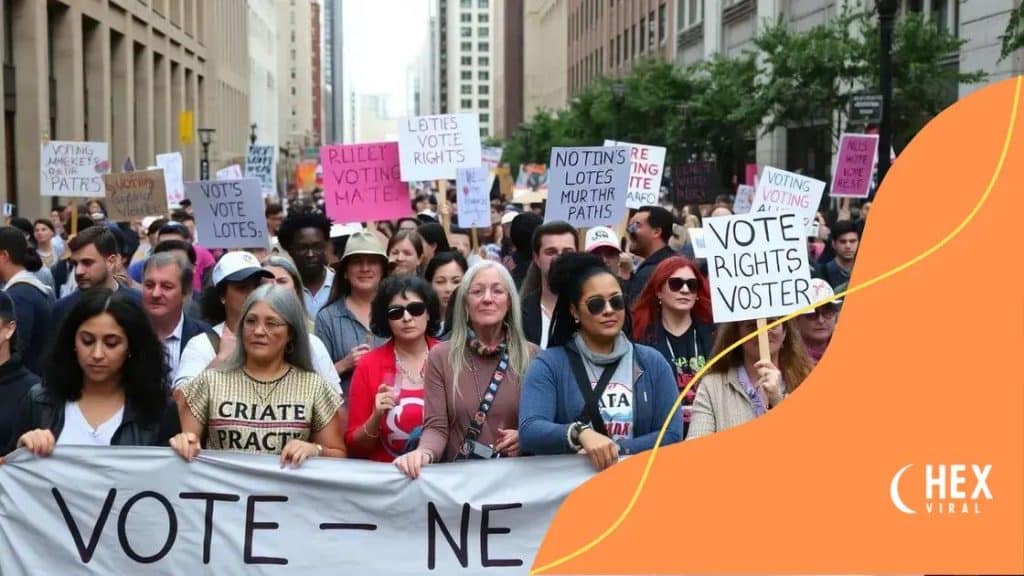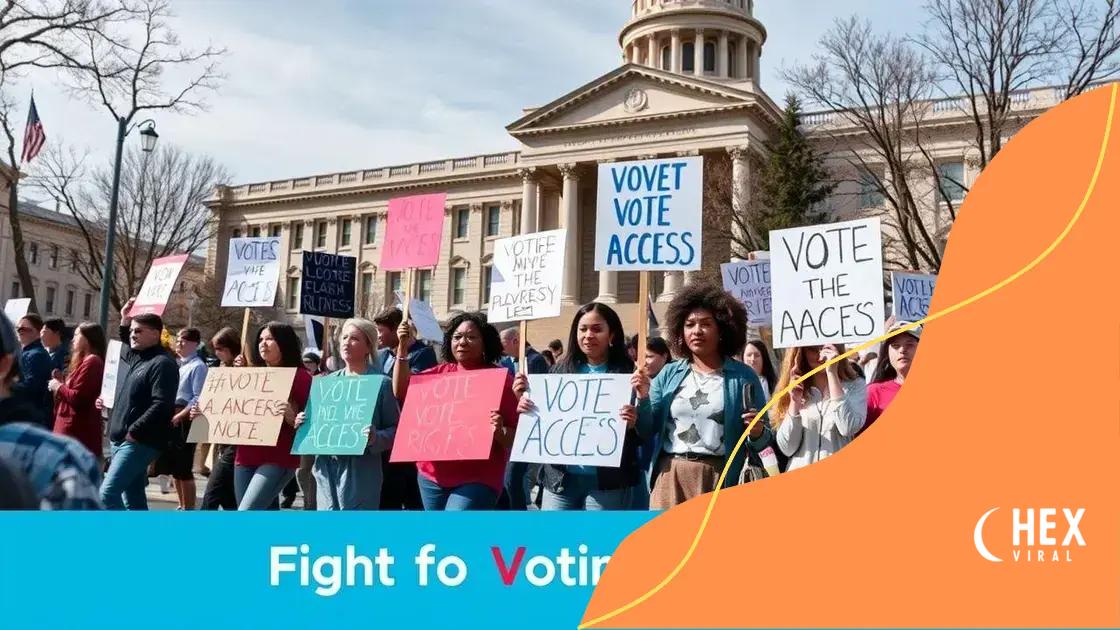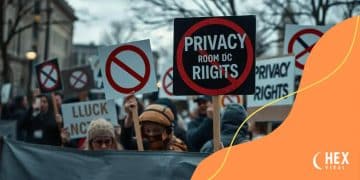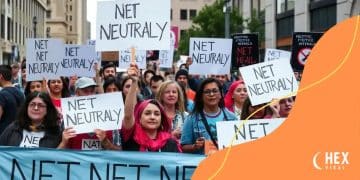Civil rights marches for voting access: why they matter

Civil rights marches for voting access played a crucial role in shaping voting legislation, highlighting persistent barriers and inspiring ongoing movements for equitable access to the ballot.
Civil rights marches for voting access have played a crucial role in shaping democracy and fighting for equal rights. Do you know how these events sparked significant changes in legislation and public awareness? Let’s dive deeper into their impact.
Historical significance of civil rights marches
The historical significance of civil rights marches is immense. These events not only brought attention to the struggles faced by marginalized communities but also led to critical changes in laws and societal attitudes. Imagine thousands of people coming together, united for a common cause: the right to vote.
One of the most pivotal marches in history was the March on Washington for Jobs and Freedom in 1963. It attracted more than 250,000 advocates and is where Martin Luther King Jr. delivered his iconic “I Have a Dream” speech. This moment served as a catalyst, driving the civil rights movement forward.
Key Impacts of Major Marches
The influence of these marches cannot be underestimated, as they achieved the following:
- Raised awareness about voting rights issues
- Mobilized individuals to take action, leading to mass participation
- Contributed to the passing of legislation such as the Voting Rights Act of 1965
- Inspired future generations to continue the fight for equality
As more people across the nation witnessed the passion and determination displayed during these marches, sentiments began to shift. It became evident that the quest for voting access was not just a local issue but a national concern that required immediate attention.
Marches also fostered a sense of community among participants. They created lasting bonds between people who might have never met otherwise. This network of support has been crucial in ongoing efforts to advocate for voting rights today.
In summary, the historical significance of civil rights marches is evident in their ability to mobilize change and foster unity among those fighting for equal voting access. The legacy of these events continues to inspire modern movements as we strive to achieve true equality for all.
Key figures in the voting rights movement
In the voting rights movement, several key figures emerged as champions for change. Their dedication and leadership were instrumental in advocating for the rights of marginalized communities, striving for equality at the ballot box.
One prominent figure was Martin Luther King Jr., a visionary leader whose powerful speeches and peaceful protests galvanized the nation. King’s commitment to nonviolent resistance inspired many to join the movement, believing that voting access was a fundamental right.
Other Notable Leaders
In addition to King, several other remarkable individuals played significant roles:
- Rosa Parks – Her refusal to give up her bus seat sparked the Montgomery Bus Boycott and highlighted racial inequality.
- John Lewis – As a young activist, he led marches and was a strong voice for the younger generation during the civil rights era.
- Ella Baker – A key organizer, she emphasized grassroots activism and helped create the Student Nonviolent Coordinating Committee (SNCC).
- Thurgood Marshall – As a lawyer, he fought against segregation and later became the first African American Supreme Court Justice.
These leaders, among many others, worked tirelessly to ensure that every citizen had the right to vote. Their efforts contributed to significant legal victories, such as the Voting Rights Act of 1965, which aimed to eliminate barriers to voting.
As we reflect on the voting rights movement, it’s crucial to recognize the impact of these key figures. Their legacies continue to inspire new generations of activists who fight for equal access to the ballot, reminding us that the struggle for voting rights is ongoing.
Impact of marches on voting access legislation

The impact of marches on voting access legislation has been profound and transformative. These demonstrations brought urgent attention to the barriers faced by citizens trying to exercise their right to vote. Through the unity and determination displayed by participants, marches have played a crucial role in shaping critical laws.
One significant outcome was the passing of the Voting Rights Act of 1965. This legislation was a direct response to the widespread activism that highlighted the injustices in voting practices. The act aimed to eliminate discriminatory practices that had long suppressed the voting rights of African Americans and other minority groups.
Key Legislative Changes Driven by Marches
Some of the major legislative impacts from these events include:
- Elimination of literacy tests: Many states used literacy tests to disenfranchise voters, particularly African Americans. Marches demonstrated the need for change.
- Federal oversight of elections: The Voting Rights Act included provisions that enabled federal oversight of areas with a history of voting discrimination.
- Flexible voting options: Marches encouraged the introduction of measures like early voting and absentee ballots, making it easier for people to participate.
- Increased voter registration efforts: Activists pushed for initiatives to simplify the registration process, encouraging more people to register to vote.
The ongoing advocacy through marches has continued to influence legislation even today. Current movements are challenging recent laws perceived as restrictive, highlighting the need to protect voting rights. It’s clear that the legacy of these marches is still felt as citizens rally for fair access to the ballot.
As communities come together in solidarity, they not only honor past sacrifices but also push for continued progress. The impact of marches on voting access legislation serves as a reminder that activism is vital in the fight for democracy.
Modern movements inspired by historical marches
Modern movements inspired by historical marches continue to shape the landscape of voting rights and social justice. Today, activists draw inspiration from the courage and determination of those who marched for equality in the past. The legacy of these historical events inspires people to unite and fight for their rights.
One notable example is the Women’s March, which began in 2017. This movement calls for gender equality and also emphasizes voting rights as fundamental for women’s empowerment. Participants wear pink hats and carry signs, echoing the spirit of past protests.
Key Features of Modern Movements
These contemporary movements often share similar characteristics with historical marches:
- Grassroots activism: Just like in the past, many modern movements rely on grassroots organizing to mobilize supporters.
- Use of social media: Activists leverage platforms like Twitter and Instagram to raise awareness and spread their messages quickly.
- Diverse coalitions: Modern movements are often made up of diverse groups, working together towards a common goal.
- Focus on intersectionality: Today’s movements consider various forms of discrimination, linking struggles for voting rights with issues like racial justice and LGBTQ+ rights.
Additionally, the Black Lives Matter movement has significantly influenced contemporary discussions about voting access. Following recent events, many advocates push for reforms that counteract voter suppression and ensure fair representation. Activists often hold rallies and events that draw attention to these pressing issues, much like the marches of the past.
As these movements continue to grow, they uphold the spirit of those who fought for voting rights in earlier decades. The lessons learned from historical marches empower today’s advocates to push for progressive change, ensuring that the struggle for justice remains alive.
Continued challenges in voting access today
Continued challenges in voting access today demonstrate that the fight for equal rights is far from over. Despite significant advancements in voting legislation, many barriers persist that prevent people from exercising their right to vote. These challenges can be seen across the United States, impacting various communities.
One major issue is voter ID laws. Many states have implemented strict identification requirements that can disproportionately affect minority and low-income voters. For some individuals, obtaining acceptable forms of ID can be difficult due to financial constraints or lack of access to transportation. This situation highlights a modern obstacle that can limit participation in elections.
Other Ongoing Challenges
Aside from voter ID laws, several other challenges affect voting access:
- Voter roll purges: Some states regularly purge their voter rolls, which can lead to eligible voters being removed without their knowledge.
- Polling place closures: Many communities face reduced access to polling places, forcing voters to travel farther and wait longer to cast their ballots.
- Limited early voting options: Not all states provide ample early voting options, making it harder for people with demanding work schedules to vote.
- Language barriers: Non-English speakers may struggle to understand ballots and voting procedures, leading to lower participation rates.
These challenges underscore why consistent advocacy is crucial. Activists and organizations are working tirelessly to address these issues and push for reforms that promote voting accessibility. Efforts include legal challenges against restrictive laws and initiatives to educate voters about their rights.
Despite the historical progress made in voting rights, the struggle for equitable access continues. Understanding and addressing these ongoing challenges is essential to ensuring that every citizen has the opportunity to participate in our democracy. By recognizing these barriers, we can work together to create a more inclusive electoral process for everyone.
FAQ – Frequently Asked Questions about Voting Rights and Access
What historical events influenced voting rights today?
Historical marches, especially those in the civil rights movement, greatly influenced voting rights by leading to key legislation like the Voting Rights Act of 1965.
What are some current challenges to voting access?
Current challenges include strict voter ID laws, polling place closures, and voter roll purges, which can hinder individuals from exercising their right to vote.
How can individuals participate in advocating for voting rights?
Individuals can participate by joining advocacy groups, attending rallies, educating others about voting rights, and voting in elections.
Why is understanding voting access important?
Understanding voting access is crucial because it helps identify barriers that need to be challenged to ensure equitable participation in democracy.






